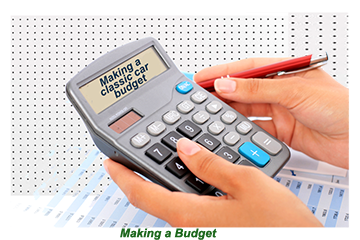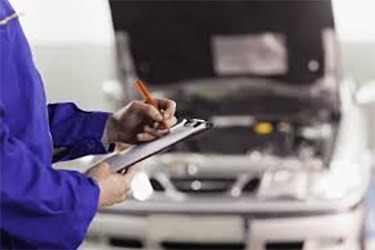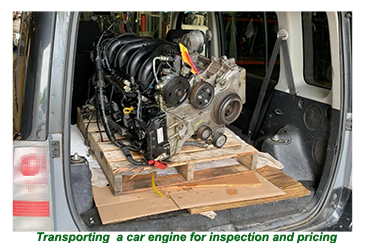 Setting a budget for restoring a classic car requires careful planning and consideration of various factors.
Setting a budget for restoring a classic car requires careful planning and consideration of various factors.
 Before embarking on a restoration project, it is essential to conduct thorough research and assessment.
One the vehicle is in the restorers possession, they can begine delving into the specifics of restoring the particualr make and model of the classic car and its current state of repair.
Please gather information regarding the availability of parts, their associated costs, and any potential challenges that may arise during the restoration process,so it can be carried out according to a plan and within budget.
Before embarking on a restoration project, it is essential to conduct thorough research and assessment.
One the vehicle is in the restorers possession, they can begine delving into the specifics of restoring the particualr make and model of the classic car and its current state of repair.
Please gather information regarding the availability of parts, their associated costs, and any potential challenges that may arise during the restoration process,so it can be carried out according to a plan and within budget.
 To successfully complete a classic car restoration, it is essential to create a detailed roadmap, outlining the necessary steps and considerations for the restoration process.
A classic car restoration process can be divided into several stages, each focusing on different aspects of the vehicle. These stages typically include the engine, body, interior, electrical system, and other relevant areas.
Thorough research on the pricing of replacement parts, materials, and tools required for the restoration process is a must, with a budget that should include a contingency buffer of at least fifteen percent to accommodate unforeseen expenses.
To successfully complete a classic car restoration, it is essential to create a detailed roadmap, outlining the necessary steps and considerations for the restoration process.
A classic car restoration process can be divided into several stages, each focusing on different aspects of the vehicle. These stages typically include the engine, body, interior, electrical system, and other relevant areas.
Thorough research on the pricing of replacement parts, materials, and tools required for the restoration process is a must, with a budget that should include a contingency buffer of at least fifteen percent to accommodate unforeseen expenses.
 When planning the project, it is vital consider how much can be handled in-house and how much will need to be farmed out.. The cost of labour can vary greatly based on factors such as the level of expertise required and the intricacy of the task at hand.
As the restoration project continues, it is essential to maintain a comprehensive record of all expenses associated with the restoration project, encompassing expenditures on parts, tools, labour, and any additional costs incurred. Tracking spending and making adjustments if necessary can be an effective way to manage finances.
When planning the project, it is vital consider how much can be handled in-house and how much will need to be farmed out.. The cost of labour can vary greatly based on factors such as the level of expertise required and the intricacy of the task at hand.
As the restoration project continues, it is essential to maintain a comprehensive record of all expenses associated with the restoration project, encompassing expenditures on parts, tools, labour, and any additional costs incurred. Tracking spending and making adjustments if necessary can be an effective way to manage finances.
![]()
 To ensure a comprehensive search for parts and materials, it is advisable to explore various sources. These sources can vary between online marketplaces, salvage yards, owner clubs and specialist classic car suppliers.
By conducting thorough research across these sources, the chances of locating the necessary parts and find the best deals, by comparing prices and quality. By evaluating both factors, informed decisions can be made
To ensure a comprehensive search for parts and materials, it is advisable to explore various sources. These sources can vary between online marketplaces, salvage yards, owner clubs and specialist classic car suppliers.
By conducting thorough research across these sources, the chances of locating the necessary parts and find the best deals, by comparing prices and quality. By evaluating both factors, informed decisions can be made
 When establishing a final restoration budget there is no shame in consult experienced classic car restorers, mechanics, and enthusiasts for advice on budgeting and the restoration process. They can provide insights into potential challenges and cost-saving tips.
When establishing a final restoration budget there is no shame in consult experienced classic car restorers, mechanics, and enthusiasts for advice on budgeting and the restoration process. They can provide insights into potential challenges and cost-saving tips.
 Budgets will probably be reviewed throughout the restoration process. Adjustments may be necessary due to unexpected challenges or new information that arises during the restoration.
Setting a realistic and multi-faceted budget is crucial to ensure the success of any classic car restoration project. By carefully planning, researching, and tracking expenses the restoration process can be completed with a minimum offinancial strain.
Budgets will probably be reviewed throughout the restoration process. Adjustments may be necessary due to unexpected challenges or new information that arises during the restoration.
Setting a realistic and multi-faceted budget is crucial to ensure the success of any classic car restoration project. By carefully planning, researching, and tracking expenses the restoration process can be completed with a minimum offinancial strain.
![]()
 With these digital images available to be clearly displayed, preferably on a laptop computer or at least a tablet, the restorer should make a tour of the relevant sub-contractors who would work on a particular segment of the restoration project.
Another factor that must be seriously considered is that the distance between the restoration nerve centre (better known as the workshop) and the relevant service supplier is considerable; transportation costs will increase.
The restorer will need to find a cost-effective way to transport the restoration vehicle to these specialists, with logistics playing a considerable part.
With these digital images available to be clearly displayed, preferably on a laptop computer or at least a tablet, the restorer should make a tour of the relevant sub-contractors who would work on a particular segment of the restoration project.
Another factor that must be seriously considered is that the distance between the restoration nerve centre (better known as the workshop) and the relevant service supplier is considerable; transportation costs will increase.
The restorer will need to find a cost-effective way to transport the restoration vehicle to these specialists, with logistics playing a considerable part.
 If the restorer has access to a light van or pickup, it can be advantageous to deliver parts for repair and restoration and pick them up when ready.
When transporting the car or its body shell complete, a trailer can be hired when needed to transport it to and from sandblasters, acid dipping, bodywork shops, or paint shops.
If the restorer has access to a light van or pickup, it can be advantageous to deliver parts for repair and restoration and pick them up when ready.
When transporting the car or its body shell complete, a trailer can be hired when needed to transport it to and from sandblasters, acid dipping, bodywork shops, or paint shops.
 All the running to and fro is vital to any restoration project as any other function and should be costed into the project.
When it comes down to the bottom line, the restorer should have as much information as possible before the restoration gets underway of costs and time to complete the project, leaving reasonable leeway for the unexpected.
Armed with all that information, a budding classic car restorer should finally be confident enough o give themselves the green light on their classic car restoration project.
All the running to and fro is vital to any restoration project as any other function and should be costed into the project.
When it comes down to the bottom line, the restorer should have as much information as possible before the restoration gets underway of costs and time to complete the project, leaving reasonable leeway for the unexpected.
Armed with all that information, a budding classic car restorer should finally be confident enough o give themselves the green light on their classic car restoration project.
Back to the homepage- and don't spare the horsepower.
Got a question, a comment, a suggestion or an offer??? - FEEL FREE TO CONTACT US ANYTIME!!;
A guide to acquiring, restoring and maintaining UK or European Classic Cars of the Fifties and Sixties- as well as a recollection of the iconic cars of the era and the visionaries that produced them.


